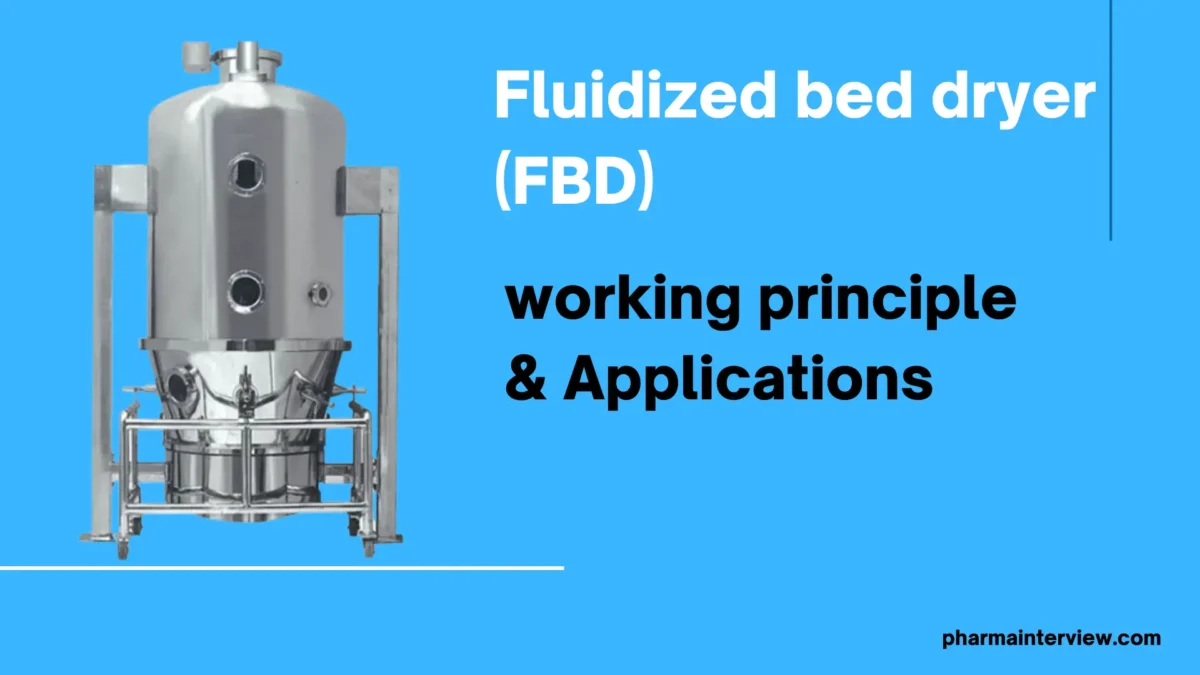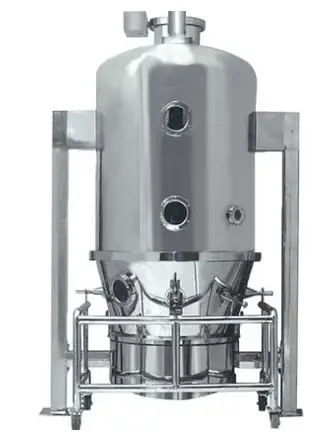Fluidized bed dryer (FBD) working principle, fluidization, pharmaceuticals, drying process, applications of Fluidized Bed Dryers.
In the manufacturing and processing industrials like food industry, pharmaceuticals, or any field requiring a effective and rapid drying process. the fluidized bed dryers (FBD) have revolutionized the drying process with its unique working principles, cost-effective operations, improve product quality, and provide versatile usability.

Fluidized bed dryer (FBD) working principle
The working principle of fluidized bed dryers is “the process of fluidization”. At the start, hot air is introduced at high pressure through the bed of solid particulate. This air passes through the solid particles at a velocity sufficiently high to suspend the solid in a fully fluidized state. The contact of hot air with solid particles triggers the process of heat transfer causing the moisture from solid particles to evaporate. The water vapor travels up along with the air stream and is eventually vented out, leaving behind dry particles. The air velocity, bed depth, and particle size and density strongly impact the efficiency of the process.
The desired or targeted end of drying process is achieved by testing loss on drying (LOD) at the end of drying process.
Fluid Bed Dryer FBD Working Principle Animation
Applications of Fluidized Bed Dryers
Fluidized bed dryers have widespread applications across various industries.
- They are especially used for drying granular materials in the pharmaceutical industry where maintaining product quality and avoiding overheating is critical.
- In the food industry, fluidized bed dryers are used for drying and cooling different food products such as corn flakes, green tea, and instant coffee. They are preferred for their high thermal efficiency, fast drying rate, and minimal risk of product degradation.
- They are also utilized in other sectors, such as waste treatment, petrochemicals, and ceramics, for their versatility, continuity, and high energy efficiency.
Basic Concepts of Fluidized Bed Dryers
Understanding Fluidized Bed Dryers
To understand fluidized bed dryers, it’s first essential to understand the concept of ‘fluidization’. Fluidization is a process that reduces the resistance of solid particles and allows them to exhibit fluid-like properties. Technically, it happens when the drag force of a fluid upward is balanced by the gravitational force of the solid particles. These particles are suspended in the fluid, creating a fluidized or suspended solid bed.

The Crucial Role of Drying Processes and Fluidized Bed Dryers in Various Industries
Drying processes are of immense importance in a variety of industries – including food, pharmaceutical, and chemical – due to their ability to decrease the moisture content in materials. The subsequent benefits include extending product longevity, reducing the weight for transportation purposes, and enhancing product quality and safety.
In these processes, fluidized bed dryers are a central equipment. Their high drying rates and efficiency make them essential. They cater to a broad range of feed variations, providing excellent control over the drying processes. The superior mixing and heat transfer abilities of these machines ensure uniform drying, thereby ensuring quality and consistency. Simplicity in design makes fluidized bed dryers easy to operate and maintain, hence they are the preferred choice for a myriad of industrial applications.
Diving into the Working Principle of Fluidized Bed Dryers
Fluidization is the process wherein a granular material in its original solid state transitions into a fluid-like state using a fluid, which could be air or a liquid. This fundamental principle underpins how a fluidized bed dryer functions, effectively drying out powdered or granular materials.
Air Preparation and Fluidisation Phase
The operation of a fluidized bed dryer begins with air preparation. In this phase, the atmospheric air is sucked into the dryer using a centrifugal fan. The sucked air passes through a series of filters where particles and impurities are removed. The filtered air then proceeds to pass through a heating system where it’s heated to the desired temperature depending on the product’s requirements.
Upon heating, the hot air is blown through the perforated distributor plate situated at the bottom of the main machine housing unit. This process causes an upward stream of air that passes through the product bed.
The air velocity and temperature are crucial in this process to ensure the particles present in the product bed remain in a suspended state, thus achieving fluidization. This state of fluidization ensures that the product particles are surrounded by hot air, allowing for an even and efficient drying process.
Product Drying and Discharge Phase
In the fluidized state, hot air carries moisture away from each individual particle in the powder or granular material. This process continues until the materials reach their desired moisture content as predetermined by the control settings. A significant aspect of this process is that the granular particles are in constant motion in the fluidized state, which ensures uniform drying.
The dried product is then discharged from the dryer. The fluidized bed dryer is designed such that the air velocity reduces towards the top of the drying chamber. This reduction in velocity allows the dried product particles to settle and then be discharged from the dryer, typically through an automatic discharge valve.
The Role of Vital Parts
Various parts of the fluidized bed dryer play integral roles in this process. The distributor plate, for instance, is crucial for distributing the heated air uniformly across the bed of material. The filtration system is vital for keeping impurities out, thereby maintaining product quality. The heating system and control settings ensure that the air is at just the right temperature for optimal drying.
The fluidized bed dryer is a dynamic drying system with applications in numerous industries. This versatile solution uses the principles of fluidization to offer rapid, efficient, and evenly distributed drying.
Advantages and Limitations of Fluidized Bed Dryery
Digging Deeper into the Functioning of Fluidized Bed Dryers
Central to the operation of a fluidized bed dryer is the concept of “fluidization”. This process occurs when a certain amount of solid particulate substance is manipulated under specific conditions such that the mixture of the solid and fluid acts like a fluid. In the context of a fluidized bed dryer, this effect is achieved by passing hot air or gas through a bed of raw materials, which causes the particles to behave like a fluid.
The hot air or gas, typically blown upwards, creates a turbulent environment, igniting the lift and mix of particles. This intense blending allows for perfect interaction between the particles and the drying gases. This harmonious unison of gas and solid does not only enable the dryer to adapt quickly to changes in processing parameters, but it also broadcasts equal drying conditions to all individual particles, giving rise to an evenly distributed, top-quality drying result.
Benefits of Using Fluidized Bed Dryers
One of the primary advantages of fluidized bed dryers is their efficiency. The intense mixing in a fluidized bed ensures near-ideal conditions for both heat transfer and mass transfer, leading to high thermal efficiency. Thus, these systems consume less energy compared to more traditional drying methods, leading to reduced operational costs.
In addition to improved efficiency, these dryers can handle a wide range of particle sizes, shapes, and densities, making them quite versatile. The intense mixing and large surface area exposed to the heat also result in comparatively short drying times, providing increased throughput.
Equally notable is the fact that fluidized bed dryers can maintain close control of residence time and temperature conditions. Therefore, they are suitable for heat-sensitive materials. Moreover, due to the vigorous mixing within the bed, there is a reduced chance of temperature variations within the bed, further preventing thermal damage to the particles.
Drawbacks and Limitations of Fluidized Bed Dryers
Despite the aforementioned advantages, fluidized bed dryers also have their limitations. One of the more significant limitations is their incompatibility with very light or fluffy materials, as these could be blown out of the bed by the upward flowing gas.
High levels of dust generation can also be observed, especially if the product being dried has a tendency to generate fine particles. This could create potentially problematic operating conditions, leading to extra maintenance, requirement for dust removal systems, and potentially even challenges with operator health and safety.
Another potential downside is the difficulty of scale-up. While fluidized beds work exceptionally well on a small scale, the efficiency and uniformity of larger beds can be challenging to maintain as maintaining homogenous flow conditions get tougher as the size of the bed increases.
Lastly, fluidized bed dryers may be less suitable for materials that have wide particle size distributions; these can lead to segregation within the bed, where smaller particles fluidize more readily, while larger ones remain largely static.
Conclusion
Overall, while the fluidized bed dryer is a potent piece of equipment in drying processes, specific limitations should be considered before their implementation. Therefore, careful evaluation of each drying process is essential to ensure that the advantages can be capitalized, and the disadvantages can be managed or mitigated.
Having explored the intriguing workings of fluidized bed dryers, it is evident that this innovative drying equipment brings immense value to industry operations. Its impressive efficiency, versatility, and capacity for enhancing product quality illuminate its worth in industrial applications. However, it is also important to recognize that, like any piece of machinery, fluidized bed dryers have certain limitations that need to be considered. Thus, the key to utilizing its potential lies in understanding its workings, advantages, and limitations. It is through this understanding that one can deploy fluidized bed dryers in an effective and informed manner, thereby optimizing drying processes and achieving the ultimate goal of industrial efficiency and superior product quality.
Join WhatsApp channel: Stay updated on pharmaceutical job opportunities, walk-in interviews, industry news, events, and pharma guidelines by joining our WhatsApp channel today.